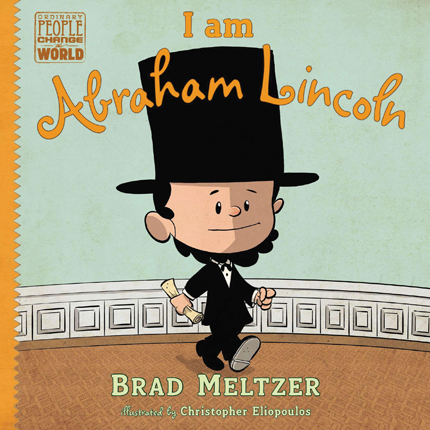| I am Abraham Lincoln (Ordinary people change the world) Author: Meltzer, Brad | ||
| Price: $21.88 | ||
Summary:
Abraham Lincoln was a kid who stood up to bullies and believed in fairness for everyone. With his powerful voice and belief that all people are created equal, he brought the country back together, ended slavery, and became one of America's greatest presidents.
| Illustrator: | Eliopoulos, Chris |
| Accelerated Reader Information: Interest Level: LG Reading Level: 3.00 Points: .5 Quiz: 165584 | Reading Counts Information: Interest Level: K-2 Reading Level: 3.20 Points: 2.0 Quiz: 75043 | |
Reviews:
Kirkus Reviews (-) (12/15/13)
School Library Journal (04/01/14)
The Bulletin of the Center for Children's Books (A) (01/14)
Full Text Reviews:
Bulletin for the Center... - 01/01/2014 Comic-book trendiness meets old-school character education in the new Ordinary People Change the World series. In each entry, a child version of the title subject narrates his or her own life story and directs listeners to embrace the lessons that made them great. For Lincoln, standing up against tormenters was key, whether they be kids who thoughtlessly abused turtles, bullies who ignored the rules of a fair fight, or pro-slavery forces who would keep countrymen in bondage. For Earhart the message is “Never let anyone stop you. Whatever your dream is, chase it,” a principle she followed despite being told time and again that women were not meant to be aviators. Eliopoulos keeps things light with sweetly silly caricatures-tiny Lincoln’s pretty adorable in his top hat and tidily scalloped beard; Earhart seems cloned from Mo Willems’ Trixie, topped with an aviator hat. There is, however, an elephant in this room Meltzer is bent on ignoring: Lincoln was assassinated despite, or because of, his integrity, and Earhart’s dreams were doused in a crash over the Pacific. A gentle reminder that heroism carries a price would not have been amiss here. Telling the whole truth, after all, is also a virtue. Photographs at the end of each title offer the audience a glimpse of what the grown-up subject actually looked like. EB - Copyright 2014 The Board of Trustees of the University of Illinois.
School Library Journal - 04/01/2014 K-Gr 2—Imagine, if you will, two famous Americans whose childhood selves were strong and portentous of their future adult lives but whose bodies stayed small and childlike as they achieved their incredible feats. Meltzer has chosen to portray these iconic figures in this way, perhaps in the hopes that modern-day kids will more easily identify with them. Both narratives are told in first person, which raises doubts as to whether they could truly be called biographies. For example, Amelia Earhart recounts an incident in which she and her sister built a ramp off the side of a shed so they could ride a cart off the roof. Her brother comes along and asks, "Amelia, are you sure this is a good idea?" She replies, "This isn't a good idea. It's the BEST idea!" Such conversations and the lack of resources calls the books' informational value into question. On the other hand, they each talk about the character traits that made Earhart and Lincoln wonderful role models and determined in their life pursuits. The illustrations, while a bit odd, are also rather charming. Their comiclike nature and the brief, readable text will appeal to young readers. Adults who read these books with children will have plenty to discuss regarding the hard work, persistence, and determination each person showed, as long as it's clear that the books themselves are fictionalized.—Maggie Chase, Boise State University, ID - Copyright 2014 Publishers Weekly, Library Journal and/or School Library Journal used with permission.



